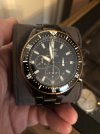I really like it. I never take it off unless I'm working with a strong magnet or something similar. It's beat up from working in the shop and vehicles etc but I like it just fine like that. I last set the time for daylight saving time and it has gained 48 seconds since then, but it's pretty consistent and that's less than 2.5 seconds a day which I think is pretty good for a "user grade" watch. Probably better than Mark's Rolex. Although he has worn his for almost 30 years and beats the piss out of it and it still functions really well. My other watch is also a Mido but I don't wear it anymore because it doesn't have a bezel on it and I actually use that pretty frequently in the shop for a lot of different things. It has the same caliber in it but it's a tuned chronometer that was remarkably accurate. I have considered having the guts swapped. If I told you the accuracy I was getting from that watch you'd think I was exaggerating. I love the mechanical watches because the amazing human ingenuity they represent in machining precision and materials science to beat half a million times a day and only miss a few beats a day. I admire that accomplishment and enjoy wearing one. Jo thinks I'm retarded. She isn't wrong.
I would not think you are exaggerating. I have owned a lot of nice mechanical watches including a Rolex GMT (which I still miss), a Breitling SuperOcean, a Rolex Two-Tone Datejust, an Omega Seamaster (still have that one), a Glashütte chronograph, an IWC . . . they can be unbelievably accurate. The most accurate one I have owned is this Grand Seiko, which is fast by a couple of seconds a
month.
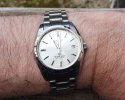
A lot of folks in the US don't know that Seiko makes some extremely accurate and
muy espensivo mechanical autos that rival and better anything from Rolex. The level of finish on this watch is extraordinary. I also have an 18K gold 31 jewel non-auto Seiko Credor certified chronometer with the certification document.
I believe this the most accurate non-radio watch you can find. Typical quartz is rated at +/- 15 seconds a month. These Precisionist movements use a different quartz and a different circuit configuration and they beat at 262 kHz. Smooth sweeping seconds hand that looks just like a mechanical movement. Mine is accurate to within about two seconds a
year.
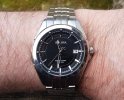
For comparison, this is what was considered state of the art accuracy circa 1970. "Railroad Approved" tuning fork watch. Accutrons set the stage for the first quartz watch, the Seiko Astron in 1969, about a decade after the first Accutrons. Rated at a minute a month - and that is still what it does.
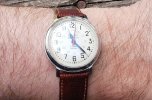
And finally, with all the hoopla over the just-released Swatch version of the Speedmaster, I have this:
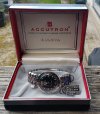
A Bulova Accutron Astronaut. In the Apollo era, NASA selected the Omega Speedmaster as the official timepiece for its astronauts. But several other timepieces were actually used in the Apollo missions, for example clocks on the command and service module, the lunar excursion module . . . . Accutron movements were used in several experiment packages, and in fact there are still at least three Accutron movements on the moon - all of which stopped working decades ago when their batteries died.
My Dad (RIP) was an Accutron nut and had several of them. I have all the papers for this one, which is about as minty as it gets. The price tag shows $175, which was a lot more dear in 1967 than today. In today's dollars, adjusted for inflation, it would be $1500.





